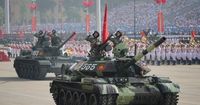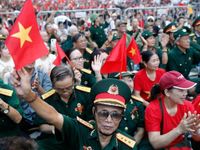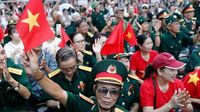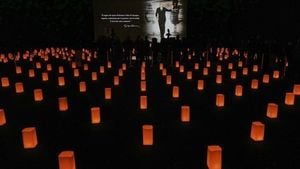Hanoi’s Ba Dinh Square was awash in a sea of red and yellow on Tuesday, as tens of thousands of Vietnamese citizens—many waving flags, some with painted faces, and others sipping iced boba tea—gathered to mark the 80th anniversary of their nation’s declaration of independence. The scene was one of jubilation and pride, but also deep reflection, as the country paused to honor a hard-fought history and look toward an ambitious future.
The day’s centerpiece was Vietnam’s largest military parade in decades, a spectacle not seen since the mid-1980s, according to reports from the Associated Press and VnExpress. Nearly 16,000 soldiers—representing the army, navy, air force, police, peacekeepers, medics, and more—marched in serried ranks through Hanoi’s heart. The parade began at Ba Dinh Square, the very spot where revolutionary leader Ho Chi Minh declared Vietnam’s independence from French colonial rule on September 2, 1945.
“In this sacred moment, we respectfully remember our ancestors,” said Communist Party General Secretary To Lam, as quoted by AFP and Vietnamese state media. “Our nation has overcome countless difficulties and challenges. Our country has transformed from a colony into an independent and unified nation, steadily advancing towards modernity.”
Lam’s speech paid tribute to those who died in the struggle for independence and reiterated the ruling party’s vision for Vietnam: “We want to be a friend, be a trusted partner with all countries in the world,” he declared, according to the Associated Press. But he also drew a line in the sand, adding that Hanoi would never compromise on independence or sovereignty—a nod to the country’s complex balancing act with powerful neighbors and global partners.
The parade itself was a dazzling display of military might and technological progress. Tanks, artillery, amphibious vehicles, and missile systems—some of them designed and manufactured domestically—rolled past the crowds. For the first time, the event included domestically made drones, cruise missiles, and the XCB-01 infantry fighting vehicle. Overhead, a formation of five Sukhoi Su-30MK2 fighter jets soared above Ba Dinh Square, tilting their wings in salute and releasing flares in a dramatic aerial display, as described by VnExpress. Russian-made Mi-171 helicopters followed, carrying enormous Vietnamese and Communist Party flags that rippled through the morning haze.
Vietnam’s show of strength was not limited to the capital. For the first time ever, a televised naval parade took place off the coast of Cam Ranh Bay in southern Vietnam. This elaborate display featured warships, submarines, helicopters, seaplanes, and a variety of naval vessels, including Kilo-class submarines and missile frigates. The naval drill was broadcast live on giant screens throughout Hanoi, allowing the crowds to witness the full scope of the country’s military prowess.
The international dimension of the parade was unmistakable. Honor guards from China, Russia, Laos, and Cambodia marched alongside their Vietnamese counterparts, with the Chinese contingent leading the foreign formations—a subtle nod to the hierarchy of Vietnam’s foreign relations. National leaders, diplomats, and foreign dignitaries, including senior officials from China and Russia, watched the parade from grandstands at Ba Dinh Square.
Vietnam’s National Day is more than a celebration of independence; it is a commemoration of resilience. The declaration of independence in 1945 was followed by years of conflict. France, refusing to recognize the new nation, returned to reclaim its Indochinese colonies, sparking the First Indochina War. The Vietnamese victory at Dien Bien Phu in 1954 forced the French out, but the country was then divided. The Communist North and U.S.-backed South fought a brutal war that ended with the fall of Saigon on April 30, 1975, and the country’s unification under communist rule.
To Lam, in his address, emphasized the continuity of Vietnam’s struggle and the guiding hand of the Communist Party. “Independent Vietnam is the crystallization of a thousand-year tradition of national construction and protection; and of steadfastness, intelligence, compassion and aspiration to rise up,” he said, according to Vietnamese state media. Lam positioned the Communist Party as both the embodiment of the Vietnamese national spirit and the sole legitimate representative of the people.
The public response was one of overwhelming enthusiasm. Some, like 22-year-old Nguyen Thi Thu Huyen, camped overnight near Ba Dinh Square to secure a spot. “It’s something to be proud of,” she told the Associated Press. “Our grandparents fought for this. Now life is better.” University student Vu Thi Trang, who staked out her position two days in advance, told AFP, “Something inside just pushed me to be here. I am grateful for the sacrifices of the previous generation, so that we have peace and freedom to grow up.”
National pride was further stoked by the government’s decision to distribute 100,000 dong (about $3.80) to each of Vietnam’s 100 million citizens as part of the anniversary festivities, according to AFP. In a symbolic gesture of reconciliation and progress, President Luong Cuong announced the early release of 13,920 prisoners, including 66 foreigners, before the end of their jail terms.
Vietnam’s transformation since the late 1980s has been nothing short of remarkable. The country has shifted from a war-torn, impoverished nation to a manufacturing powerhouse, supplying global giants like Samsung and Nike with electronics, textiles, and footwear. Poverty rates have plummeted and a burgeoning middle class is reshaping the nation’s economy and aspirations. Yet, challenges remain. Vietnam must navigate rapid economic growth, demographic shifts, climate risks, and ongoing disputes over sovereignty in the South China Sea—all while maintaining its delicate relationships with major powers such as China and the United States.
The anniversary parade also served as a reminder of Vietnam’s evolving international posture. By including foreign contingents and showcasing advanced military hardware, the country signaled both its growing self-confidence and its commitment to being a “trusted partner” on the world stage, as To Lam put it. But the message of independence and sovereignty was just as clear—Vietnam’s leaders remain determined to chart their own course, come what may.
As the last echoes of martial music faded and the crowds dispersed, the sense of unity and pride lingered in the air. For many, the day was a powerful affirmation of how far Vietnam has come—and a promise of how much further it intends to go.






